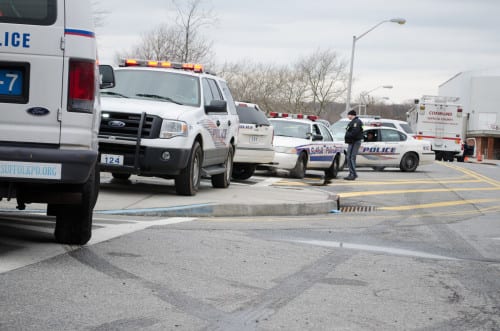
The nation is reckoning with the institution of policing, but university police departments, which emerged as higher education began to diversify, are often left out of the conversation.
On Nov. 12, the Humanities Institute hosted a virtual lecture, “Policing University Space: How Law and Order Infiltrated the Campus,” as part of the “Abolitionist Futures” series.
One PhD candidate in history, Turner Fellow and an AERA Minority Dissertation Fellow at Stony Brook University, examines the rise of the carceral state in relation to demographic shifts on college campuses across the country in her research.
“It can be easy to think that the walls and gates of universities seem to be detached from the outside world,” the student said. “This quickly challenges previously held assumptions that university served as some sort of safe haven or escape from issues of policing.”
The PhD candidate delivered this lecture to an audience of about 40 people who had the opportunity to contribute to the discussion during the Q&A segment at the end of the lecture.
As higher education began to diversify in the 1970’s, with the rise in enrollment of Black and Latinx students, universities faced pressure to police students in line with the national narrative at the time, which called for law and order. The proportion of Black and Latinx students increased from 8% in 1964, to about 22% by 1972 according to the student. Universities had to decide between embracing social justice discourses or constructing their own policing mechanisms, mainly university police departments.
The candidate’s dissertation is titled: “Campus Eyes: University Surveillance and the Policing of Brown and Black Student Activism in the Age of Mass Incarceration, 1960-1990.”
Her dissertation examines the rise of university police departments and traces their designs starting with the 1960’s, up until where they are today by scouring administrative memos, student newspapers and police reports.
“It tells the story of how public universities have historically weighed the needs of Black and Latinx students against the nation’s growing impulse toward law and order,” the student said. “The history of campus policing is the making of a police force, not in the 19th century, but in the modern era, just 50 or 60 years ago, in the very midst of the civil rights movement.”
Before 1960, universities sometimes had unarmed guards without uniforms. Today, nine out of 10 public universities have their own fully-established police department which often operates as a central part of the university.
75% of campuses have armed officers and 81% of sworn officers have jurisdictions beyond the boundaries of campus, causing the surrounding communities to be policed double when they fall under two jurisdictions.
For 150 years, Student Affairs was the “original disciplinarian,” with the role of supervising student behavior, according to the student’s research. She described the historical shift that took place when the university relinquished the role to the growing policing departments. They wanted to focus on being educators and counselors, instead of “amateur policemen,” which allowed them to embrace values of diversity and social justice.
“When you have any amount of Black students on the campus, or any amount of students of color on a campus, it’s really important to address the police presence and see why it’s there,” Oreoluwa Adewale, the president of the SBU’s NAACP chapter said. “We need to look into what exactly their rules are and why certain rules and regulations are put into place, because I do believe it affects like Black and Brown students a lot more.”
The shift comes down to several internal and external factors which took place as the law and order narrative grew. Lawmakers pushed to regain control on what they perceived to be chaotic campuses, as protests by Black and Latinx students unraveled across the country.
“What [the student’s] work does is not only to center policing, and surveillance as a punitive forest, but also to center it right in the heart of the attempt to create post 1965 diversity,” Robert Chase, her thesis advisor and respondent said during the lecture. “Her research aims into the public university, the creation of that multiversity and the glorification of ideals of racial, ethnic and class diversity.”
Emerging police departments continued to apply pressure in order to expand what was in their purview. They wanted to gain legitimacy by incrementally pushing for more power in the form of arms and resources. Uniforms were highly contested for a while, as were gun carrying restrictions.
“For those of us who study the history of police, we know that police didn’t always exist. Certainly not,” the student said. “In the case of university policing. It’s not a given that police, prisons or any institution has to exist in their particular current form forever.”
She noted that as the nation debates the merits of reform versus abolition, university police departments should be looked at as an embodiment of community policing that already exists. These officers are more educated, undergo cultural diversity training and exist in a community policing model, but she questioned if this actively implemented model has worked.
“Campus police departments are one of the most important places that we need to look at when we’re thinking about this ongoing national conversation about policing,” she said. “Could campuses be places where perhaps we experiment with the idea of defunding the police model and divert that money toward mental health?”
Updated 10/26/2023 at 1:15 p.m.: The PhD candidate’s name has been removed from this article for anonymity.










